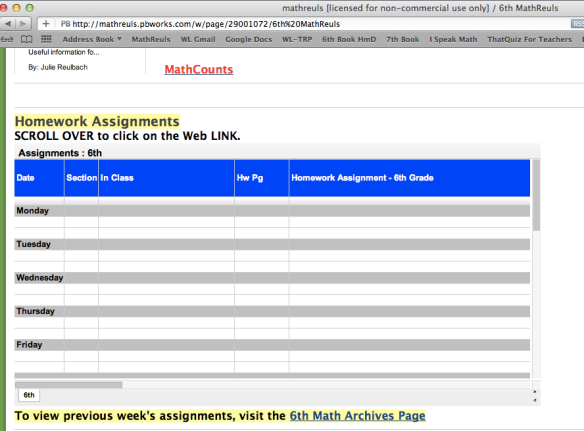I do not grade homework. I have been teaching a long time, so I have tired everything (see the list of blogs I have written about homework at the end of this post). Over the years I have graded homework for correctness and completion. In most cases I found that homework grades artificially inflated a students grades, and in some cases brought students grades down. Most importantly, because of help from friends, tutors and parents, homework grades rarely represent what the students actually know.
I would love for my students to engage with math outside of class time for about 20 minutes a day. I do not want my students feeling lost, overwhelmed, or frustrated at home if they do not understand the homework. And I want the students to feel that the homework is important because it is relevant to the work that we do in class.
I do not grade homework, but I do walk around each day to see if students had any questions on their homework (check if students are doing it). If they do not, I have them fill out a Homework Responsibility Sheet that I keep on file. Still, without the promise of a grade, homework completion has not been as consistent as I would like. I use the CPM (College Preparatory Mathematics) curriculum, and the spiraling homework is an important part of the curriculum, as the problems increase in difficulty each time they appear in the Review/Preview. In CPM, the class lessons are a set of problems the students work through as a team in a “guided” discovery model. Then, they have a set of spiraling problems called “Review / Preview” that they do for homework. Since the homework is spiraling, it is not what the students have done in math classes before (example: 2 – 30 evens of the same exact type of problem they did in the lesson). So, some of my students do not feel that the homework is related to classwork. Additionally, the spiraling homework can be challenging if students have forgotten how to do a concept. So over Christmas Break, I came up with a new homework system.
Instead of assigning the “Review / Preview” problems at the end of the section for homework, I assign ONE problem from the next section.
This problem is usually the very first problem we would have worked on in class the next day. Usually the first problem is not too difficult for them to do, because it is an introductory problem that reviews past skills as an introduction to a new concept. When students come in the next day, they get the ONE problem out and talk about their answers. I walk around the room to check students answers and to see if everyone is participating. Once we are finished reviewing this problem, we can jump right into the next problem in the lesson. This “jump starts” the lesson, enabling us to finish the section early. And then, the students have time to work on their “Review / Preview” in class. This way they have each other, and me, as a resource while they tackle the more challenging review problems.
My students absolutely love the new system. The work that they are doing at home is not too difficult, and connects to the work that we are doing in class. The more difficult “Review / Preview” homework is done in class where other students and I can help them. I did have some students not doing the ONE problem when I first switched over, but since it was the first problem of the lesson, they felt lost through most of class, even when their classmates tried to catch them up. This has encouraged more consistent completion of their ONE homework problem. As I tell them, everyone usually has the time to do just ONE problem, right?
UPDATE: We just reached the end of the chapter, and there were some important problems that we did not get to during class time, as it’s difficult for some students to finish all of the Review/Preview problems during class time. At the end of the chapter I assign the closure problems. There usually aren’t that many closure problems and the kids are always asking for more practice. So, I went back through the chapter and re-assigned the important problems that most students were not able to get to in addition to their closure problems. It did not add that many problems as I was careful not to assign duplicates, especially if they were easier ones that the closure problems. Since we work on closure problems in class, I am excited to know that the kids will have done almost all of the Review / Preview, in class, for probably the first time ever. I definitely expect this to strengthen their skills!
My Past Posts About Homework:
- Homework Responsibility Binder
- Supporting Students: Homework
- Assigning Desmos Homework
- To Grade or Not To Grade: Homework In Math Class
- I Just Can’t Grade Homework
- Differentiating Math Homework
- Homework Choice Allows Differentiation and Encourages Creativity
- The Homework Paradigm
- Homework Paradigm – Part II or Wanna Be Happy? Then don’t grade homework
- Homework Policies – MS Sunday Funday
















